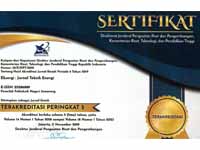Experimental Study of the Performance of a Horizontal Axis Wind Turbine with A Flat Taper Type of 4:5 and an Outer Angle of 25° With Variations in The Number of Blades
DOI:
https://doi.org/10.32497/eksergi.v21i03.7110Keywords:
horizontal axis wind turbine, 25° outlet angle, taper 4:5, number of blades, system efficiencyAbstract
This experimental study investigates the performance of a Horizontal Axis Wind Turbine (HAWT) with a flat taper 4:5 blade design and a 25° exit angle, focusing on the effect of varying the number of blades (6, 9, and 12). The turbine, with a diameter of 1.1 m and blade dimensions of 470 mm length, 110 mm top width, and 137 mm bottom width, was tested at wind speeds of 3 m/s, 5 m/s, 7 m/s, and 9 m/s in a laboratory setting. Parameters such as wind speed, turbine rotation, voltage, and current were measured to analyze system efficiency. The results indicate that blade count and wind speed significantly influence efficiency. The highest efficiency of 12.51% was achieved at 3 m/s with 9 blades, while at 5 m/s, the efficiency peaked at 3.95% with 9 blades. For higher wind speeds (7 m/s and 9 m/s), the optimal efficiency decreased to 2.03% and 0.95%, respectively, both achieved with 6 blades. The study concludes that this turbine design is most effective at low wind speeds (≤5 m/s), making it suitable for regions with similar wind conditions, such as Indonesia. The findings contribute to optimizing blade configurations for small-scale wind energy applications.
References
[1] ESDM, K. (2024). Hingga 2030, Pemerintah Bidik Tambahan Kapasitas Terpasang PLTB 5 GW. Kepala Biro Komunikasi, Layanan Informasi Publik, Dan Kerja Sama. https://www.esdm.go.id/id/media-center/arsip-berita/hingga-2030-pemerintah-bidik-tambahan-kapasitas-terpasang-pltb-5-gw.
[2] Fachri, M. R., & Hendrayana, H. (2017). Analisa Potensi Energi Angin dengan Distribusi Weibull Untuk Pembangkit Listrik Tenaga Bayu (PLTB) Banda Aceh. CIRCUIT: Jurnal Ilmiah Pendidikan Teknik Elektro, 1(1), 1–8. https://doi.org/10.22373/crc.v1i1.1377
[3] Sahid, Mulyono, Totok Prasetyo, Dwiana, Y. dan M. F. (2022). Turbin Angin Poros Horizontal Tipe Flat Sudu Banyak Taper 4:5 dan Sudut Keluaran 25°. In Jurnal Rekayasa Mesin (Vol. 17, Issue 1, p. 169). https://doi.org/10.32497/jrm.v17i1.3086
[4] Aryanto, F., Mara, I. M., & Nuarsa, M. (2013). Terhadap Unjuk Kerja Turbin Angin Poros Horizontal. Dinamika Teknik Mesin, 3(1), 50–59
[5] Herlambang, Y. D., & Wahyono, W. (2019). Rancang Bangun Turbin Angin Poros Horizontal 9 Sudu Flat Dengan Variasi Rasio Lebar Sudu Top Dan Bottom Untuk Meningkatkan Kinerja PLTB. Eksergi, 15(2), 70. https://doi.org/10.32497/eksergi.v15i2.1508.
[6] Sahid, Dwiana, Yanuar, A. (2020). Turbin Angin Poros Horizontal Tipe Flat Sudu Banyak Dengan Perlakuan Sudut Luaran. Prosiding Seminar Nasional NCIET, 1(1), 326–335. https://doi.org/10.32497/nciet.v1i1.126
[7] Sahid, Mulyono, Totok Prasetyo, Dwiana, Y. dan M. F. (2022). Turbin Angin Poros Horizontal Tipe Flat Sudu Banyak Taper 4:5 dan Sudut Keluaran 25°. In Jurnal Rekayasa Mesin (Vol. 17, Issue 1, p. 169). https://doi.org/10.32497/jrm.v17i1.3086
[8] Suwoto, G., Teknik, J., Politeknik, M., & Semarang, N. (2018). Karakterisasi Turbin Angin Sudu Flat. 3(1), 1–11.
[9] Bourhis, M., Pereira, M., & Ravelet, F. (2022). Experimental investigation of the effect of blade solidity on micro-scale and low tip-speed ratio wind turbines. Experimental Thermal and Fluid Science, 140. https://doi.org/10.1016/j.expthermflusci.2022.110745.
[10] Adi Sayoga, I. M., Wiratama, I. K., Mara, M., & Catur, A. D. (2014). PENGARUH VARIASI JUMLAH BLADE TERHADAP AERODINAMIK PERFORMAN PADA RANCANGAN KINCIR ANGIN 300 Watt. Dinamika Teknik Mesin, 4(2), 103–109. https://doi.org/10.29303/d.v4i2.59
[11] Dicky, J. (2020). Pengujian Kinerja Turbin Angin Darrieus – Savonius Dengan Kapasitas Maksimum 300 Watt. Fakultas Teknik, 21–23.
[12] Dony Damara. (2016). Analysis Rotor Horizontal Axis Wind Turbine (Hawt) With Variation Geometry And Number Of Blade For Capacity 10 Kw
[13] E. Hasan, M., Eltayesh, A., I. Awaad, M., & M. El-Batsh, H. (2023). Experimental Examination for the Electric Power Generation of a Commercial Small-scale Wind Turbine with Modified Aerodynamic Design. Alexandria Engineering Journal, 64, 25–39. https://doi.org/10.1016/j.aej.2022.08.040
[14] Siregar, I. H., Effendy, M., & Rasyid, A. H. A. (2023). Pengaruh Jumlah Bilah Pengarah Angin Jenis Omnidirectional Terhadap Kinerja Model Turbin Angin Savonius. Otopro, 18(2), 65–70. https://doi.org/10.26740/otopro.v18n2.p65-70
[15] Lovibond, O., & Dvorak, V. (2023). Machine Translated by Google Konversi dan Manajemen Energi : X dinamika fluida komputasional. 17(November), 1–16K. ESDM, “Hingga 2030, Pemerintah Bidik Tambahan Kapasitas Terpasang PLTB 5 GW,” 2024. https://ebtke.esdm.go.id/artikel/siaran-pers/hingga-2030,-pemerintah-bidik-tambahan-kapasitas-terpasang-pltb-5-gw
Downloads
Published
Issue
Section
License
Copyright (c) 2025 Faranita Putri Anandia, Sahid Sahid, Anis Roihatin

This work is licensed under a Creative Commons Attribution 4.0 International License.
Authors who publish with this journal agree to the following terms:Authors retain copyright and grant the journal right of first publication with the work simultaneously licensed under a Creative Commons Attribution License that allows others to share the work with an acknowledgement of the work's authorship and initial publication in this journal.
Authors are able to enter into separate, additional contractual arrangements for the non-exclusive distribution of the journal's published version of the work (e.g., post it to an institutional repository or publish it in a book), with an acknowledgement of its initial publication in this journal.
Authors are permitted and encouraged to post their work online (e.g., in institutional repositories or on their website) prior to and during the submission process, as it can lead to productive exchanges, as well as earlier and greater citation of published work (See The Effect of Open Access).






